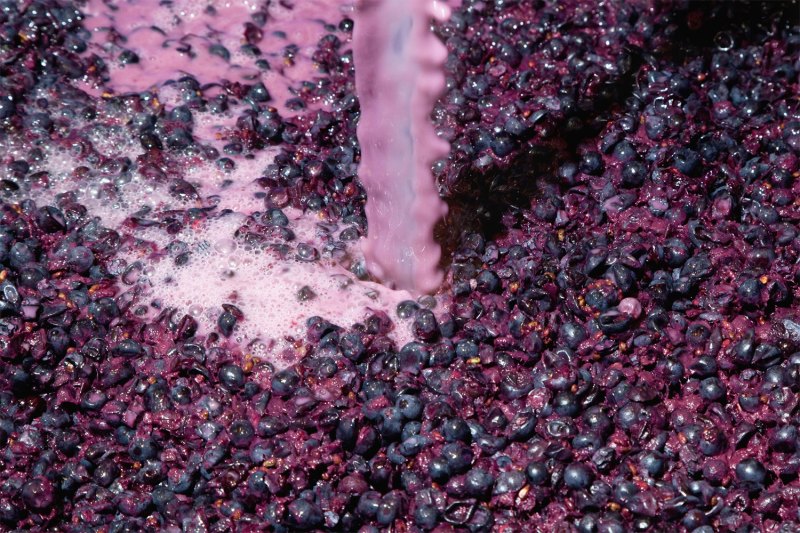Carbonic maceration is without a doubt one of the cooler phrases in winemaking. It sounds like the name of an epic electronic band or the title of a great sci-fi sequel.
In reality, the term refers to a particular style of fermentation at the winery. Grapes ferment while fully intact and still in their skins, creating an unctuous wine with a low tannin count. These wines are juicy and ready to drink pretty much right when they’re bottled, unlike more conventionally produced wines which require more time to even out.

Carbon dioxide persuades the grapes to ferment and is introduced to tanks and bins to create an anaerobic climate. Whereas more traditional winemaking fermentation banks on yeast and its impact on pressed juice, this approach is full of countless mini-fermentations. Inside every grape, a tiny fermentation is sparked by CO2. Meanwhile, the weight of the fruit naturally presses some of the lower layers of clusters, creating some free run juice (part of the saignée approach).
The rise in bright, immediately approachable wines like Gamay Noir in the last decade has popularized the style. But it goes back to Beaujolais in France, where the style was perfected and first noted by scientists in the 19th century. Because it’s a mostly natural approach, carbonic maceration in some form of another goes back much farther, before the days of yeast strains, climate control, and more became the norm.
Carbonic maceration almost always involves red grapes, as the phenolic transformation tends to backfire with whites, creating off-flavors or unwanted aromatics. It has a long history in France but is being utilized by other European countries, too. In the states, intrepid producers are using carbonic maceration to make their own nouveau-style wines, packed with freshness. Even the coffee realm is showing interest in the style.
At Corollary Wines in the Willamette Valley, the focus is on bubbles. Husband-and-wife team Jeanne Feldkamp and Dan Diephouse planned to celebrate their first vintage at a wine bar in Portland earlier this year. But the pandemic and resulting lockdown had other ideas.
The couple believes that Oregon’s most famous appellation is the best place on planet Earth for making sparkling wine. They gained an angle after tasting some memorable wines abroad, lifted by the distinctive fermentation style. “We’re big fans of carbonic in general,” Feldkamp says. “Whether it’s Lapierre in Morgon or Hervé Souhaut in the Rhone, these wines and their hedonistic aromatics are just so delicious we have a hard time keeping any in our cellar.”
She says carbonic maceration was a big part of the duo’s winemaking journey and a cellar decision that could the character of Oregon Pinot Noir in sparkling wine. “Carbonic creates aromatics that really jump out at you,” she continues. “Raspberry, cherry, tangerine, and cranberry all make appearances in our Momtazi Vineyard cuvée.”
There are challenges, of course. Feldkamp says the fruit must be handled with care so that no berries get crushed. “This is why we pick directly into fermentation bins and only fill them part way,” she says. Then there’s the issue of balance. “We want it to add another dimension, but not overwhelm.”
That means gently stomping of the grapes for careful extraction, managing temperature, and trying to hold on to the uniqueness of the site (something Momtazi has a lot of). Too much extraction, and bitterness can take over. Not enough, and you lack the color and structure necessary for a good wine. Meanwhile, you’re making sure the fermentation is still moving along and, if you’re like most winemakers, you’re dealing with a handful of other fermentations, rackings, pressings, and more at the same time.
“The final challenge is acid retention,” she says. “Because the carbonic maceration process eats up all the malic acid in the juice, you end up with a softer wine compared to traditional fermentation. This can be part of the appeal if you do it right, though. For us, a softer wine that also offers great texture and savory aspects from the saignée process can be incredibly food-friendly — even for foods you wouldn’t traditionally associate with sparkling wine, like pork chops!”
Carbonic maceration has the ability to make lighter, fresher wines with some less expected flavors. For the impatient wine drinker who lusts for instant gratification, the cellar method is a godsend. It’s also a great way to enjoy wines with plenty of structure and, generally, lower ABV levels. Drop the term the next time you’re at the bottle shop or looking for something new and different to buy online.


